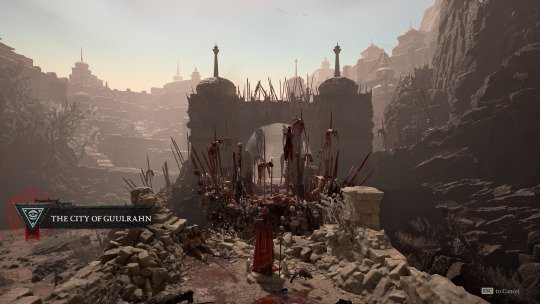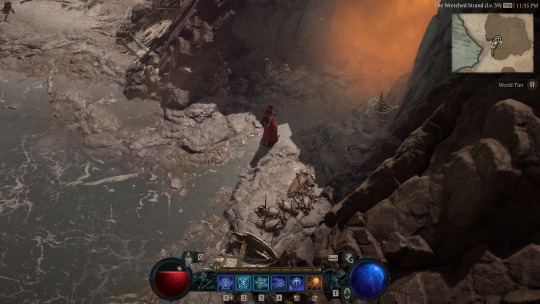progress shields us from the terrors of an uncertain future
Don't wanna be here? Send us removal request.
Text




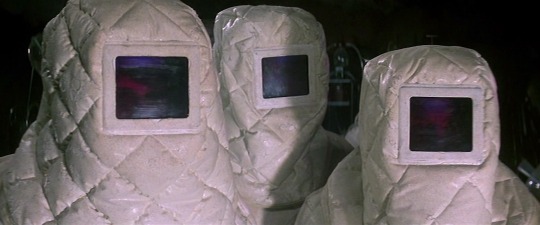


Dune (1984). Cinematography by Freddie Francis
503 notes
·
View notes
Text

NANOGRAV's 15-Year Journey Reveals a Cosmic Hum
June 28, 2023, Mountain View, CA – Gravitational waves play a cosmic symphony as they pass through our galaxy. Today the North American Nanohertz Observatory for Gravitational Waves (NANOGrav) Physics Frontiers Center released the results of 15 years of data in a set of papers published in The Astrophysical Journal Letters. This research is the first evidence of gravitational waves at very low frequencies. The team, comprised of 190 scientists, including SETI Institute researcher Dr. Michael Lam, transformed our region of the Milky Way Galaxy into an immense gravitational-wave antenna using pulsars. NANOGrav's endeavor involved collecting data from 68 pulsars, fashioning a pulsar timing array—a distinctive type of detector.
“It's incredibly exciting to have helped open a new window to the Universe,” said Lam.
5 notes
·
View notes
Text
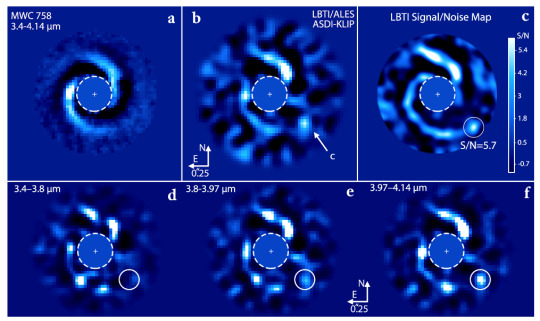
Direct images and spectroscopy of a giant protoplanet driving spiral arms in MWC 758
Understanding the driving forces behind spiral arms in protoplanetary disks remains a challenge due to the faintness of young giant planets. MWC 758 hosts such a protoplanetary disk with a two-armed spiral pattern that is suggested to be driven by an external giant planet. We present new thermal infrared observations that are uniquely sensitive to redder (i.e., colder or more attenuated) planets than past observations at shorter wavelengths. We detect a giant protoplanet, MWC 758c, at a projected separation of ~100 au from the star. The spectrum of MWC 758c is distinct from the rest of the disk and consistent with emission from a planetary atmosphere with Teff = 500 +/- 100 K for a low level of extinction (AV<30), or a hotter object with a higher level of extinction. Both scenarios are commensurate with the predicted properties of the companion responsible for driving the spiral arms. MWC 758c provides evidence that spiral arms in protoplanetary disks can be caused by cold giant planets or by those whose optical emission is highly attenuated. MWC 758c stands out both as one of the youngest giant planets known, and also as one of the coldest and/or most attenuated. Furthermore, MWC 758c is among the first planets to be observed within a system hosting a protoplanetary disk.
1 note
·
View note
Text
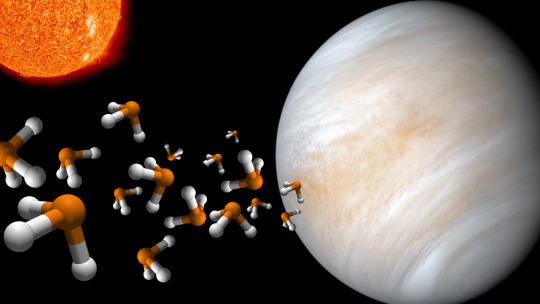
Life on Venus? Intriguing molecule phosphine spotted in planet's clouds again
The Venus phosphine saga continues.
In September 2020, a team of scientists led by Jane Greaves of Cardiff University in Wales reported the detection of phosphine, a possible indicator of life, in the clouds of Venus. The announcement sparked a heated debate and a surge of follow-up studies, which have generally failed to spot the intriguing molecule in the Venusian atmosphere.
Now there's a new twist. Speaking at the Royal Astronomical Society's National Astronomy Meeting 2023 in Cardiff this week, Greaves revealed the discovery of phosphine deeper in the atmosphere of Venus than it had been spotted before. Using the James Clark Maxwell Telescope (JCMT) at the Mauna Kea Observatory in Hawaii, Greaves and her colleagues delved into the atmosphere of Venus, down to the top and even the middle of the planet's clouds.
2 notes
·
View notes
Text

The unions of Hollywood are trying to save it from itself
Fran Drescher, SAG-AFTRA president and the creator of the iconic Fran Fine, stepped up to the microphone, vibrating with fury. She was there with a small group of SAG-AFTRA members to announce their first strike since 1980. “The eyes of the world and particularly the eyes of labor are upon us,” Drescher said. “The gravity of this move is not lost on me, or our negotiating committee, or our board members who have voted unanimously to proceed with a strike.”
This strike is different. It’s far more complicated than just wanting a bigger cut of the hit films and TV shows that actors and writers helped create. A rapid shift toward streaming — coupled with the existential threat posed by AI — has created a canyon between what Hollywood writers and actors want and what the country’s largest media companies are willing to give. As Drescher so bluntly puts it: “You cannot change the business model as much as it has changed and not expect the contract to change too.”
1 note
·
View note
Text
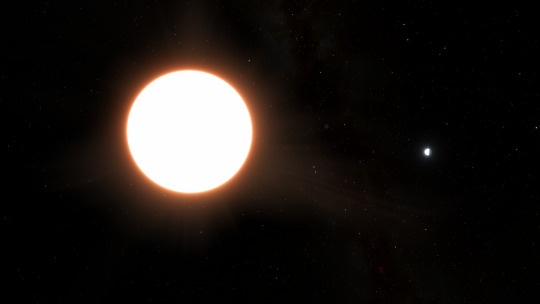
Cheops shows scorching exoplanet acts like a mirror
Data from ESA’s exoplanet mission Cheops has led to the surprising revelation that an ultra-hot exoplanet that orbits its host star in less than a day is covered by reflective clouds of metal, making it the shiniest exoplanet ever found.
1 note
·
View note
Text

STEREO-A Comes Home
STEREO-A is coming home in the summer of 2023 for the first time since it was launched 17 years ago and is providing amateur astronomers with a unique opportunity to do some citizen science. The spacecraft has inferior conjunction with Earth on August 17, 2023 and will be approximately 8.2 million kilometres distant then. While still far from Earth, STEREO-A will be unusually close to Earth and produce a unique opportunity to decode its deep space beacon and view stunning images of the Sun as it approaches solar maximum. In solving this riddle in the sky we present how we figured out how to decode STEREO-A’s images and present a suggestion of how to celebrate STEREO-A’s return to the vicinity of home.
1 note
·
View note
Text

Monster gravitational waves spotted for first time
Gravitational waves are back, and they’re bigger than ever.
After the historic first detection of the space-time rattles in 2015 using ground-based detectors, researchers could have now rediscovered Albert Einstein’s waves with an entirely different technique. The approach tracks changes in the distances between Earth and beacon stars in its Galactic neighbourhood called pulsars, which reveal how the space in between is stretched and squeezed by the passage of gravitational waves.
Whereas the original discovery spotted waves originating from the collision and merger of two star-sized black holes, the most likely source of the latest finding is the combined signal from many pairs of much larger black holes — millions or even billions of times the mass of the Sun — slowly orbiting each other in the hearts of distant galaxies. These waves are thousands of times stronger and longer than those found in 2015, with wavelengths of up to tens of light years. By contrast, the ripples detected since 2015 using a technique called interferometry are just tens or hundreds of kilometres long.
3 notes
·
View notes
Text
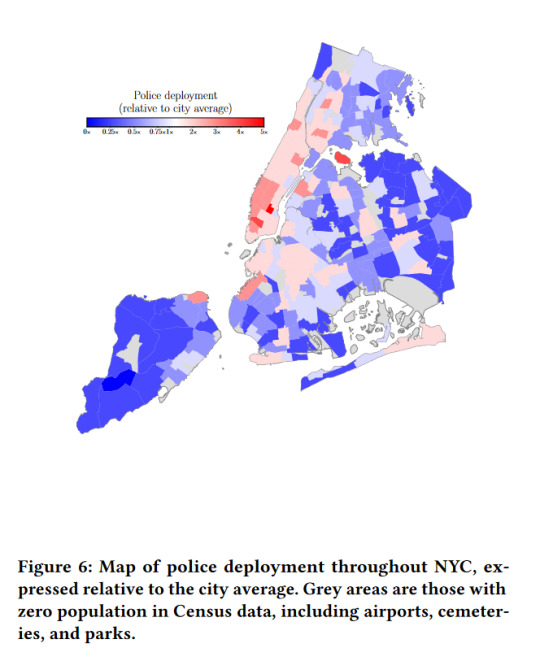
Detecting disparities in police deployments using dashcam data
Large-scale policing data is vital for detecting inequity in police behavior and policing algorithms. However, one important type of policing data remains largely unavailable within the United States: aggregated police deployment data capturing which neighborhoods have the heaviest police presences. Here we show that disparities in police deployment levels can be quantified by detecting police vehicles in dashcam images of public street scenes. Using a dataset of 24,803,854 dashcam images from rideshare drivers in New York City, we find that police vehicles can be detected with high accuracy (average precision 0.82, AUC 0.99) and identify 233,596 images which contain police vehicles. There is substantial inequality across neighborhoods in police vehicle deployment levels. The neighborhood with the highest deployment levels has almost 20 times higher levels than the neighborhood with the lowest. Two strikingly different types of areas experience high police vehicle deployments — 1) dense, higher-income, commercial areas and 2) lower-income neighborhoods with higher proportions of Black and Hispanic residents. We discuss the implications of these disparities for policing equity and for algorithms trained on policing data.
1 note
·
View note
Text
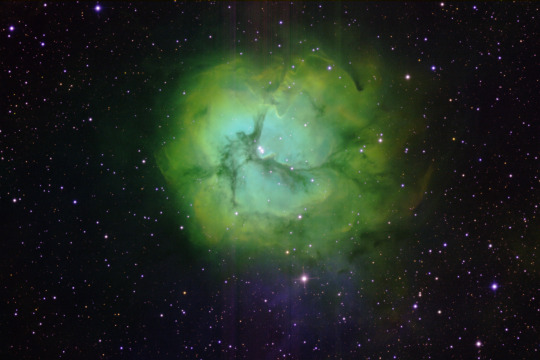
M20, the Trifid Nebula, using data processed from a remotely accessible telescope in Chile.
1 note
·
View note
